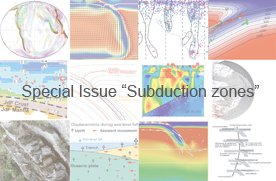Using open sidewalls for modelling self-consistent lithosphere subduction dynamics
Abstract. Subduction modelling in regional model domains, in 2-D or 3-D, is commonly performed using closed (impermeable) vertical boundaries. Here we investigate the merits of using open boundaries for 2-D modelling of lithosphere subduction. Our experiments are focused on using open and closed (free slip) sidewalls while comparing results for two model aspect ratios of 3:1 and 6:1. Slab buoyancy driven subduction with open boundaries and free plates immediately develops into strong rollback with high trench retreat velocities and predominantly laminar asthenospheric flow. In contrast, free-slip sidewalls prove highly restrictive on subduction rollback evolution, unless the lithosphere plates are allowed to move away from the sidewalls. This initiates return flows pushing both plates toward the subduction zone speeding up subduction. Increasing the aspect ratio to 6:1 does not change the overall flow pattern when using open sidewalls but only the flow magnitude. In contrast, for free-slip boundaries, the slab evolution does change with respect to the 3:1 aspect ratio model and slab evolution does not resemble the evolution obtained with open boundaries using 6:1 aspect ratio. For models with open side boundaries, we could develop a flow-speed scaling based on energy dissipation arguments to convert between flow fields of different model aspect ratios. We have also investigated incorporating the effect of far-field generated lithosphere stress in our open boundary models. By applying realistic normal stress conditions to the strong part of the overriding plate at the sidewalls, we can transfer intraplate stress to influence subduction dynamics varying from slab roll-back, stationary subduction, to advancing subduction. The relative independence of the flow field on model aspect ratio allows for a smaller modelling domain. Open boundaries allow for subduction to evolve freely and avoid the adverse effects (e.g. forced return flows) of free-slip boundaries. We conclude that open boundaries in combination with intraplate stress conditions are to be preferred for modelling subduction evolution (rollback, stationary or advancing) using regional model domains.






